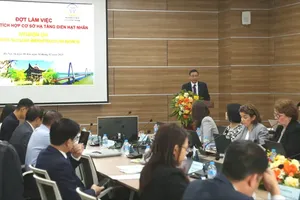
The National Digital Transformation Day on October 10 shows the great attention of both the national and local leaders to such an important information technology aspect. It is a signal of the responsibility of state management units as well as the Vietnamese IT business community.
The digital transformation process includes the establishment of a digital government, economy, and society with various smart cities. It is considered the only choice during the 2021-2025 period for breakthroughs in socio-economic development and improvements in living standards of citizens, plus a favorable environment for competitiveness enhancement among businesses, local areas, and the whole nation in general.
Giant telecoms corporations such as Viettel, VNPT, and FPT are playing the role of boosting collaboration in the communities of innovative startups as well as small and medium-sized enterprises to offer more digital services for the state, businesses, and citizen, in hope of creating a new Vietnam via successes in the national digital transformation process.
The Vietnamese Government has always considered the digital infrastructure, data infrastructure, and national digital platforms as the key in this process, and is striving to accelerate the process. Digital businesses are expected to be the essential factor in fulfilling the aim of Vietnam’s digital economy accounting for 20 percent and 30 percent of the national GDP in 2025 and 2030, respectively.
To promote digital transformation, besides Resolution No.52-NQ/TW, issued by the Politburo on September 27, 2019 and Resolution No.50-NQ/CP, issued by the Government on April 17, 2020, all localities have introduced their own resolutions regarding this matter. Seeing such a determination, the public and businesses, especially digital ones, have joined hand to strongly respond to the State’s call.
The aims of the national digital transformation process are to improve the living standards of all residents, the citizen satisfaction index, while boosting the growth of GRDP and the administrative reform, the innovation capacity of all local areas. However, the ultimate goal is to transform the mind and habits of people, which is the most challenging task. They have to understand the benefit of digital technologies to their life and willingly carry out this process.
For instance, farmers and businesses have wholeheartedly participate in digital transformation in agriculture, clearly seeing the high profit it can deliver. The situation is the same in the fields of education, traffic, healthcare. Understanding the convenience of digital transformation, citizens find it easier to change their habits of performing daily activities accordingly. This, in turn, will become the driving force for the success of the national digital transformation.
Technologies should answer the demands of the real life and must exist in daily activities of the public, not merely plans in conferences or topics of discussions among technicians. In fact, during the fourth outbreak of the Covid-19 pandemic, digital products have appeared out of innovation to address problems at that time such as distance diagnosis for Covid-19 patients. They have been highly appreciated by the community.
Until June 2022, all 35 national digital platforms were completely developed, 31 of which were formally launched. In addition, the Ministry of Information and Technology has cooperated with related ministries and state agencies to develop and announce 50 digital platforms. Among them, 18 are for the digital government, 16 for digital economy, and the other 16 for digital society. All 63/63 localities have been directed to launch at least 1 digital platform. 43/63 localities have announced their choice of digital platform in 2022 in their own digital transformation plan.
The percentage of eligible public services provided online at level 4 is 97.3 percent, while the proportion of online public services generating dossiers is 45.7 percent (1.6 times as high as this time last year) and the one of online processed documents is nearly 27 percent (a rise of 10 percent compared to 2021).
(Source: the Information and Communications Ministry)
























